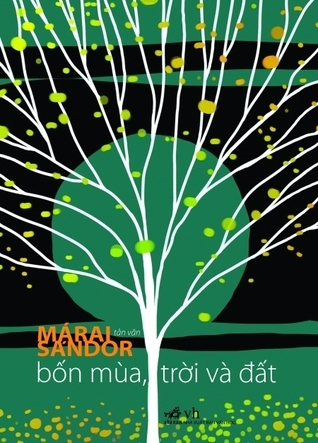
Bốn mùa (1938), Trời và Đất (1942), mượn ẩn dụ từ sự trải nghiệm cuộc sống, qua những quy luật linh thiêng mà hiển nhiên: đất- trời, cao- thấp, sự tuần hoàn luân chuyển của vạn vật qua nóng- lạnh, héo- tươi, sinh- diệt... để làm phát lộ những ẩn khuất trong mối tương quan giữa con người, giữa lý tưởng và bản năng, giữa những cách thức khác nhau để trở nên "vĩnh cửu" về mặt tinh thần, viết... Márai đã phát hiện khía cạnh nhân tính trong những ý niệm tưởng chừng vô luân, những giá trị cao cả trong điều vụn vặt. Một hình dung về F. R. Chateaubriand khi không mang "vòng hào quang" người đời gán ghép, nhanh nhảu rẽ vào nhà thổ. Một Goethe "cháu ông thợ may" chưa bao giờ thành đạt, ở Weirma. Lòng nhân từ trái khoáy khi mua được phẩm hạnh con người trong nhà chứa... Bằng ngôn từ tinh tế nhưng sắc bén, khả năng theo đuổi những liên tưởng vừa trữ tình đáng kinh ngạc, Márai đồng thời tạo ra một thế giới ứ đầy chất thơ, với vẻ đẹp tráng lệ và não nùng của cuộc sống đang vận động đến sự lụi tàn sầu thảm tất yếu, nhưng kiêu hãnh với những giá trị tinh thần bền vững.
Author

Sándor Márai (originally Sándor Károly Henrik Grosschmied de Mára) was a Hungarian writer and journalist. He was born in the city of Kassa in Austria-Hungary (now Košice in Slovakia) to an old family of Saxon origin who had mixed with magyars through the centuries. Through his father he was a relative of the Ország-family. In his early years, Márai travelled to and lived in Frankfurt, Berlin, and Paris and briefly considered writing in German, but eventually chose his mother language, Hungarian, for his writings. He settled in Krisztinaváros, Budapest, in 1928. In the 1930s, he gained prominence with a precise and clear realist style. He was the first person to write reviews of the work of Kafka. He wrote very enthusiastically about the Vienna Awards, in which Germany forced Czechoslovakia and Romania to give back part of the territories which Hungary lost in the Treaty of Trianon. Nevertheless, Márai was highly critical of the Nazis as such and was considered "profoundly antifascist," a dangerous position to take in wartime Hungary. Marai authored forty-six books, mostly novels, and was considered by literary critics to be one of Hungary's most influential representatives of middle class literature between the two world wars. His 1942 book Embers (Hungarian title: A gyertyák csonkig égnek, meaning "The Candles Burn Down to the Stump") expresses a nostalgia for the bygone multi-ethnic, multicultural society of the Austro-Hungarian Empire, reminiscent of the works of Joseph Roth. In 2006 an adaptation of this novel for the stage, written by Christopher Hampton, was performed in London. He also disliked the Communist regime that seized power after World War II, and left – or was driven away – in 1948. After living for some time in Italy, Márai settled in the city of San Diego, California, in the United States. He continued to write in his native language, but was not published in English until the mid-1990s. Márai's Memoir of Hungary (1944-1948) provides an interesting glimpse of post World War II Hungary under Soviet occupation. Like other memoirs by Hungarian writers and statesmen, it was first published in the West, because it could not be published in the Hungary of the post-1956 Kádár era. The English version of the memoir was published posthumously in 1996. After his wife died, Márai retreated more and more into isolation. He committed suicide by a gunshot to his head in San Diego in 1989. Largely forgotten outside of Hungary, his work (consisting of poems, novels, and diaries) has only been recently "rediscovered" and republished in French (starting in 1992), Polish, Catalan, Italian, English, German, Spanish, Portuguese, Czech, Danish, Icelandic, Korean, Dutch, and other languages too, and is now considered to be part of the European Twentieth Century literary canon.